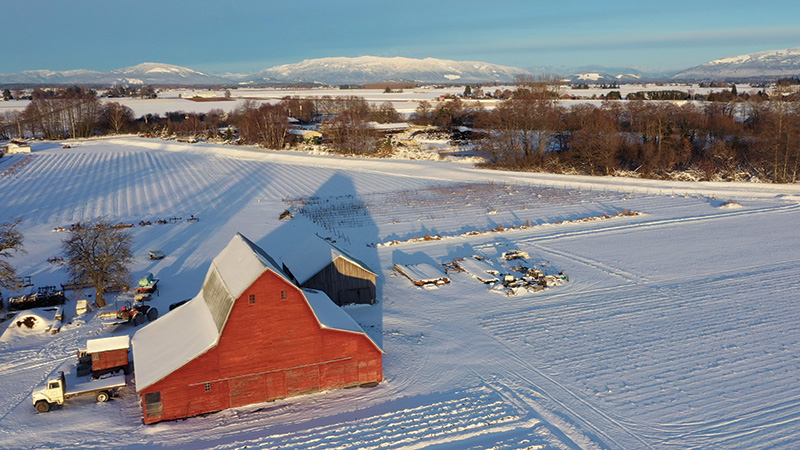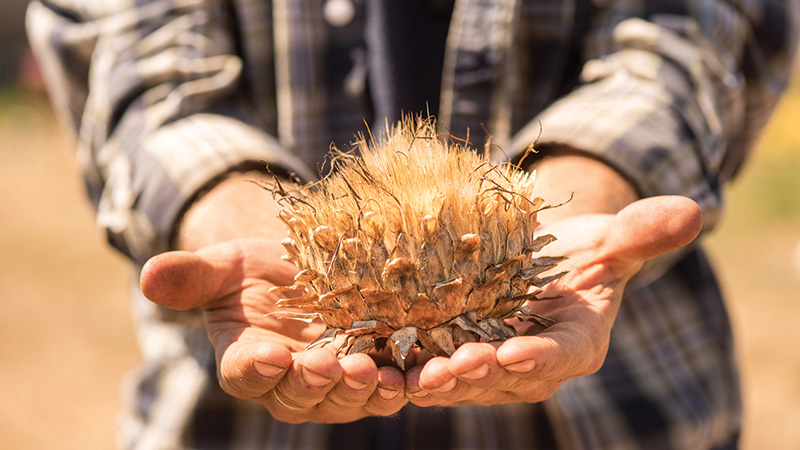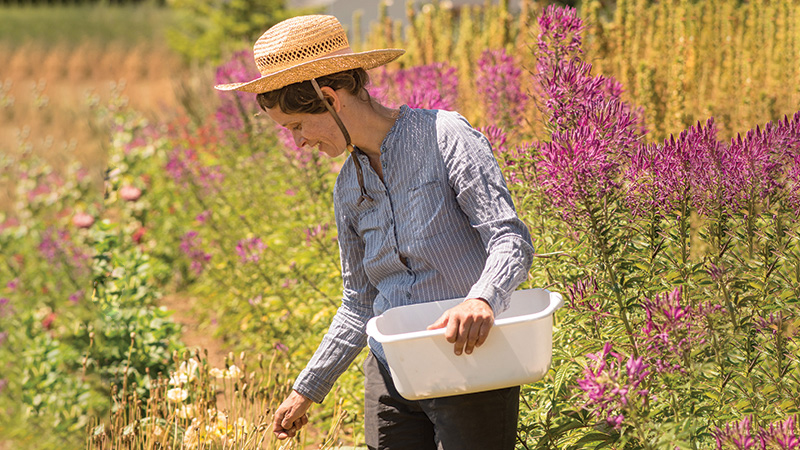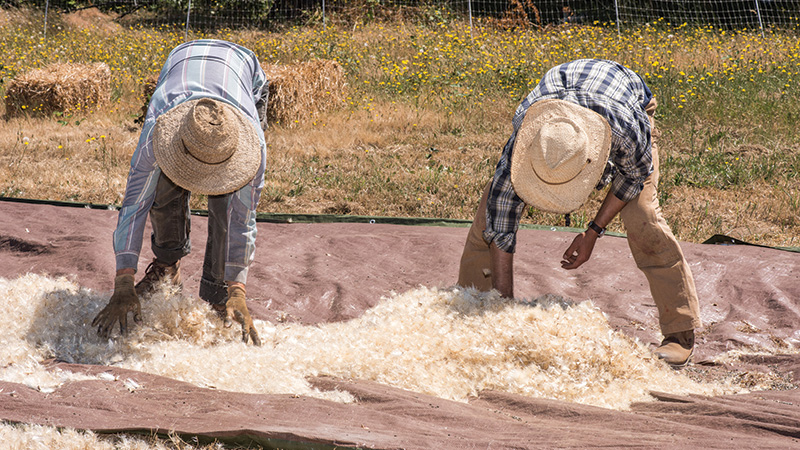Living and Farming in the World’s Seed Bank
By Georgie Smith, guest contributor
This article was originally published in March 2022

Photo by Karen Ducey.
I once flew halfway around the world to find farmers in a remote village in China harvesting truckloads of cabbage raised from cabbage seed grown in my Pacific Northwest backyard.
As a fourth-generation Pacific Northwest farmer, I wasn’t surprised. While the Pacific Northwest is well known for harvests like apples and cherries, it’s also been a top contributor for generations to the global vegetable and flower seed supply.
“During World War I, over 95% of the world’s seed cabbage production came out of this little valley here,” said Skagit Valley farmer Dave Hedlin. “Even today, if you have sauerkraut in New York City or kimchee in Korea, there’s a better than 50% chance that the seed that grew that crop came from here.”
Hedlin is the owner of Hedlin Farms, a La Conner farm known for its locally grown organic produce and grains (see Tilth Farmer of the Year story). Hedlin Farms produced its first cabbage seed crop in 1906, part of a Washington commercial seed crop industry that predates statehood.
“We are highly diversified, but vegetable seed pays a lot of our bills,” Hedlin said. Many Pacific Northwest farmers can say the same thing.
The harvests are under the radar for the average consumer, and their impacts are therefore sometimes underappreciated. That seed harvest is priceless for both the region and the globe.
Small acreage, big money
The first Pacific Northwest seed company, Tillinghast, was founded in 1885 and also based out of La Conner, contracting with local farmers to produce seed. They eventually distributed an annual seed catalog under the Tillinghast name until 1993. Tillinghast staged their seed sales out of a marvelously musty old warehouse building as you entered La Conner town limits. As a child, I loved pawing through bins of seed packages and boxes of sprouting seed potatoes on our annual family trek to Tillinghast for our kitchen garden seeds, an obvious precursor to my lifelong love affair with seed and growing plants.
Today, the commercial seed crop production takes up relatively few acres but is worth big money. In 2019 approximately 4,110 acres worth $16.1 million were planted into seed crops in eight Pacific Northwest counties—Clark, Clallam, Cowlitz, Island, Jefferson, Lewis, Snohomish and Whatcom, according to statistics from Skagit County Washington State University (WSU) extension services.
Skagit and Snohomish counties alone produce around 75% of the U.S. supply of cabbage seed and 25% of the world’s cabbage seed—and that’s just cabbage. All told, the Pacific Northwest is a world-leading producer of more than 35 “small-seeded” vegetable crops. We grow a significant portion of the U.S. and world supply of crops like table beets, spinach, arugula, broccoli, Chinese cabbage, coriander, mustard, parsley, parsnip, rutabaga, swiss chard, turnips and a wide variety of flowers and more than 90 countries import our seed, according to the WSU-Mount Vernon NW Research Center.
Hedlin Farms has even been contracted to grow evening primrose, a native North American flower known for its lovely night-blooming flowers and pressed to produce an oil used in herbal medicine. My personal favorite unusual seed crop was the year our neighbors leased 5 acres of our Whidbey Island farmland for a crop of coriander seed (aka cilantro gone to seed). It smelled heavenly when in full bloom!

Photos by Shawn Linehan.
Why here on the 47th parallel?
Several factors make the Pacific Northwest the perfect place for producing many seed crops.
We have highly productive growing regions—the “Magic Skagit,” as it is known, is famous for its world-class soils. In central Whidbey, the Ebey’s Prairie farmland is prized for seed production because it typically doesn’t flood out during the winter season, unlike agricultural areas with river systems.
Then there’s our generally mild winters plus the daylight extremes of life on the 47th parallel—both are crucial for “vernalizing” biennial crops like cabbage, Brussels sprouts, beets and parsnips. In the second year of their life, biennial crops produce seed, triggered (aka vernalized) to flower after receiving a certain amount of cold plus lengthening daylight hours. The average Pacific Northwest winter weather is chilly enough to start vernalization without winter-killing crops, which happens in the extremely low temperatures typical in most of North America (including Eastern Washington).
But the real secret is the one that many Pacific Northwesterners know but try to keep under wraps: Despite our rainy reputation, summers into early fall are reliably dry and rain-free, but not too hot.
“Our predictably dry weather in the summertime without being extreme is really kind of an unusual combination in the world of farming,” says Brian Campbell, co-owner of Uprising Seeds, a Whatcom County seed producer. “A lot of the West, it’s just too hot at the time of flowering for many of the types of seeds we grow.”
“Beet-ing” disease cycles
Another local seed-growing advantage is the many regional microclimates that favor different seed crops and break disease cycles. In some cases, the waters of Puget Sound play a role as well.
For instance, in the 1940s, Skagit Valley beet seed growers were experiencing catastrophic losses caused by the beet mosaic virus (BtMV), a disease spread by aphids. That was a pretty big deal, considering Skagit County has long been a major world producer of table beet seed, producing 95% of the U.S. and 50% of the world’s supply of table beet seed.
Beet seed is a biennial crop planted in the summer and overwintered. Beets go to flower the second year of their life. But, keeping the beets in the same field for two years allowed BtMV to persist on the live, overwintered plants and then act as a “green bridge”—as plant biologists call it—for aphids to spread the virus to new, first-year beet fields planted nearby.
The solution was just across the water.
Skagit Valley growers agreed to stop growing the first year of the beet cycle in the Skagit and moved that production to nearby Whidbey Island fields. Come spring, those first-year beets are dug up and transported by truck across Deception Pass Bridge, crossing the narrow sliver of ocean separating the north end of Whidbey Island from the Skagit County mainland. Aphids can’t fly across. In the Skagit, the best beet roots are selected and replanted for their final year of flowering and seed setting and the transmission cycle of BtMV is stopped before it can begin.
Right now, about a half-mile from my farm, is an unimpressive 10-acre field of what looks like long dirt mounds, easily tens of thousands of beets tucked away so they don’t freeze out over the winter. In March or April (depending on how wet the coming spring is), the beet digging equipment will arrive and truck those beets off—just as they have since my father was a young boy.
Complexity and cooperation
At one level growing seed is amazingly simple—just let your plants mature, set flowers and collect the seed. It can also be incredibly complex—is your cabbage seed crop planted too close to somebody’s overwintered kale that went to flower? Oops, you just accidentally crossed cabbage and kale and now have a commercially worthless seed crop!
Other seed crops, like spinach, have specific rotation requirements to prevent disease cycles. For example, to avoid a total crop loss from spinach fusarium wilt disease, Pacific Northwest growers must follow a 12 to 15-year crop rotation cycle. Considering the annual market value for spinach seed alone runs into the double-digit millions, crop rotation is taken seriously amongst seed producers.
So, every spring, all the local seed growers do something that would be anathema in many other business sectors—they cooperate. It’s called “pinning” because that’s what they do, placing pins on a map of where everyone wants to plant the coming season’s seed crops and adjusting as needed, making sure isolation requirements are met to prevent any cross-pollination.
In Skagit County, pinning days traditionally occurred the first weekday of March and June, held at the WSU-Mount Vernon NW Research Center offices. A giant county map dominated the stage. More recently the Skagit pinning tradition went “electronic,” says Don McMoran, Skagit County WSU Extension director. Growers now use online maps and a computer program to pin their seed crop locations.
Secrecy doesn’t work in seed production, which Campbell points out is the whole point of pinning. “You can be competitors, but you have to cooperate. One person not playing along with the program, not only does it ruin it for everyone else, it ruins it for them too.”
The commercial seed growers are happy to cooperate to keep their valuable seed crops isolated. But in recent years, small farmers, backyard home gardeners and seed savers unaware of their commercial seed industry neighbors have created “some contentious moments,” says Joe Christianson, a Skagit Valley farmer and seed grower whose family has been growing seed crops since 1926. Joe’s great-grandfather Alf Christianson founded a seed company in Mount Vernon (since sold to Sakata Seeds, a Japanese-founded international seed producer with Skagit Valley headquarters).
In 2017 Skagit County extension estimated approximately $1 million in lost seed crops due to “unpinned” brassica crops like home and small farm plantings of cabbage, kale, broccoli and even ornamental flowering kale allowed to go to seed. It got bad enough that the Washington State Department of Agriculture (WSDA) took the unusual step of saying they would take legal action against Brassica seed growers that didn’t coordinate their growing locations with other growers.
It wasn’t something anybody wanted to do. As Christianson says, “Any farmer doesn’t want somebody telling them what to do, so we understand.” But it’s critical to the industry and farmer’s livelihoods—not to mention the global seed supply and, ultimately, world food production.

Food heritage: Rockwell Beans
While we talk a lot about the large-scale global impact of seed production, seed crops also have a regional, cultural impact on the Pacific Northwest’s place-based agricultural and food heritage. Such is the case of the Rockwell bean.
The Rockwell is an attractive white and red-speckled bean, a heritage bean crop in the central Whidbey area since the late 1800s and locally cherished as a popular baked bean. However, it was never grown commercially, not well suited to mechanical harvesting equipment. Instead, central Whidbey’s pioneering farming families—including my own—kept the cultivar alive by annually growing out a few rows, hand-threshing them and saving seed for replanting the following year.
Several years ago, I sent a small mason jar of Rockwell bean seed to Campbell to trial for his seed production. While I was growing around 2,000 pounds of Rockwell beans a year at that time, I was selling my beans direct to Pacific Northwest chefs—they were more inclined to eat them than perpetuate them. Getting more Rockwell beans into the hands of fellow bean-growing aficionadas would mean the Rockwell would persist whether I was growing them or not! Indeed, Campbell began growing Rockwell bean seed for inclusion in Uprising’s annual seed offerings, where it has been well received by small farmers and local gardeners.
“It’s been an anchor in our catalog for many years now. It’s one we’re really proud of,” Campbell says. Uprising Seeds (sold at PCC stores) is a “farm-based” seed producer, following a model quite a bit different than what commercial seed farmers like Hedlin or Christianson do. In fact, companies like Uprising are part of a “wave of small seed companies,” Campbell says, rising like a tide against a seed industry that has been consolidating for decades. Today, four global seed companies—Bayer, Corteva, ChemChina and Limagrain—control more than 50% of the world’s seeds, and 75% of the global crop varieties disappeared between 1900 and 2000, according to the UN Food and Agriculture Organization.
Commercial seed growers are contracted to grow seed for middlemen seed producers. Then that seed is redistributed worldwide through farm wholesale and well-known retail seed catalogs like Burpee or Territorial Seeds. But it’s all the same seed, coming from relatively few farm fields, just repackaged under different seed catalog names. (Whereas seed from Uprising’s catalog was most likely produced by the Uprising farmers themselves.)
Uprising grows 75% of the seeds they sell (approximately 400 to 450 individual varieties) on their farm, contracting out just a few crops they can’t grow well with small seed producers.
Many of Uprising’s varietals are rare seeds, like the Rockwell bean, helping to preserve crop genetic diversity. But Campbell believes the real impact of regional seed growers like himself goes beyond seed diversity. For him, seed production is about creating a sense of place around food production, starting from the very beginning—with seed.
“Creating a culture around food and a sense of place with agriculture that connects people and brings them together, that is really the most critical role that we can play,” Campbell says.
For long-time commercial seed growers like Christianson, it’s a matter of educating consumers. Many people never even consider where seed comes from, or the complexity of producing seed.
“They think seed just grows out of the ground naturally or something,” Christianson said.
McMoran agrees. Consumers need a better appreciation of the seed crop industry and what it means to both our regional farm culture and food security. Growing seed crops helps farmers like Hedlin, Christianson and Campbell keep farmland in production and fill up grocery shelves.
It’s not just the farmers growing the food to be applauded, but the farmers behind the scenes as well. The ones growing the seed to be turned into food.
“A good majority of consumers don’t realize where their food comes from,” McMoran says. “If you don’t have good quality seed to start with, you’re not going to have a good product for the consumer. It’s the cycle of life, a giant circle.”
One that for many crops, begins right here.

Seed-Saving Tips for Urban Gardeners
If you can grow it, you can save its seed. That’s true even in a city garden.
Even a postage-sized garden or a collection of patio pots can be used for seed saving by applying and scaling down the same basic rules commercial seed growers follow.
“Do what you can with the space you’ve got,” advises Katie Miller, research field assistant for the Organic Seed Alliance and co-owner of Saltwater Seeds, growing Pacific Northwest-adapted seeds on the Olympic Peninsula.
Miller put her head together with Adrianna Moreno of Empowered Flowers, an Oregon-based market farmer and contract seed grower, to provide these tips for Pacific Northwest gardeners.
Set your seed-saving intentions
Define your seed-saving goals, Moreno recommends. Are you trying to identify cold-hardy plants? Rain tolerant? Do you want to select plants for flavor? Color? Scent? Especially for a home gardener, clear goals will help you choose what plants to save seed from.
“You’re not going to be saving seed from 300 plants. You’re going to save seed from maybe 10 plants,” Moreno says. “If you’re selecting for something like flavor, taste them all and save the 10 plants that you really want.”
Hone your observation skills
Success in seed-saving and breeding comes down to paying attention, Moreno says. Start doing so from the moment you open a seed packet. Do a seed count and weigh them. How many seeds per gram? Note the seeds’ color, appearance and how clean they are. Write down observations and refer to those notes when selecting and processing seed from the plants you grew from that packet.
Keen observation will guide your success and develop your seed-saving skills over time.
“There are times when I’m cleaning seed and I have to really look closely at the seed,” Moreno says. “Am I damaging the seed hull? Am I scratching it? Am I throwing away a bunch of good seed?”
Learn plant characteristics important to seed saving
There are three basic components of plant biology that new seed savers should understand before they start seed saving, Miller says.
A: Open Pollinated Versus Hybrid Plants
Open-pollinated plants are varieties that have a stable genetic pool. Seeds collected from open-pollinated plants grow a plant that looks like its parents.
Hybrid plants were crossed from two different, genetic strains. Plants grown out from their seed will express a high variability of traits.
Yes, open-pollinated plants are simpler for new seed savers to work with, Miller says. But don’t be afraid of hybrids. Just know you’ll likely end up with “something different from what you saved from.”
B: Self-Pollinating Versus Cross-Pollinating Plants
Self-pollinating plants pollinate themselves. So, you don’t need as many plants to maintain a stable seed strain.
Cross-pollinating plants, on the other hand, pollinate each other. That means seed savers need to select and save from a larger population of plants to maintain a genetically stable strain. That can be hard for gardeners with limited space. Although some types of cross-pollinating plants that can be grown densely—like arugula—can still work for seed saving in a small area, Miller says.
C: Wet Seed Versus Dry Seed
Some plants, like lettuce or beans, produce dry seed, which is generally easy to harvest and process. Other crops—like tomatoes, cucumbers, melons and squash—have seeds encased in wet, pulpy flesh and require more work to produce viable seeds.
Wet-seeded crops require a fermentation process and must be soaked in water and decanted several times until the good seeds sink and the bad seeds float.
Start simple
Starting with easy-to-save species helps you learn about the seed-saving process and develop your skills as you go, Moreno says.
Open-pollinated strains from self-pollinated plants with dry seeds—like beans and peas—are an obvious first choice. Tomatoes are also popular and easy to save seed from, as long as you understand the wet-seed process.
Moreno recommends lettuce for beginners. “Lettuce is easy to grow. It’s really easy to clean. It’s a winner. All elements are easy.”
Save what you’re excited about
Don’t be afraid to try saving seed from more challenging plant species or plant breeding goals!
“If you do want to grow some outcrosses, I would not advise people to shy away from it,” Miller says. “You can always reinvigorate the genetic diversity of a population by trading with friends or buying more of the same seed.”
Moreno agrees.
“Gardening, in general, can be really challenging work,” Moreno says. “If you’re saving seed on something that you’re really excited about, you’re leading with pleasure. I think that is one of the biggest elements about gardening in general.”
Georgie Smith is a fourth-generation farmer on Whidbey Island. She writes about food and farming.
Learning more
Visit the Organic Seed Alliance at seedalliance.org for a list of resources, a seed-saving library, and announcements on upcoming Pacific Northwest seed-saving educational events.
